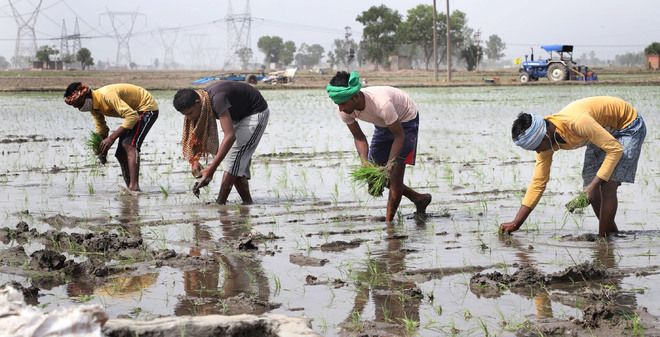Ajay Joshi
Tribune press service
Jalandhar, August 2
Contrary to the Department of Agriculture’s target of covering over 32,000 hectares of land under the direct seeding paddy method or direct seeding rice (DSR) method, only 21,670 hectares of land could be covered under the DSR method this year. The expected figure was double that of last year since only 16,800 hectares of land were covered by the DSR method.
In addition, the area under paddy has also decreased by nearly 2,000 hectares this year. Despite the lockdown, last year 1,73,000 hectares of land was covered with paddy crops, and this season the area has been reduced by 1,71,600 hectares. Interestingly, more farmers showed interest in sowing Basmati rice and its cultivated area also increased by 900 hectares. The total area remained at 21,900 hectares.
In order to replenish the depleted water level, the administration had to include 32,000 hectares of land under the DSR, as the technique saves up to 25% of groundwater while farmers do not have need to make puddles, which also saves labor costs.
But, despite the organization of various camps to sensitize farmers to direct sowing paddy, a majority of farmers opted for the traditional sowing method. In addition, only 25,000 hectares of land was cultivated using machinery, said agricultural officer, Surinder Singh. Apparently, poor power supply, delayed monsoon and water shortage have forced farmers to reduce the area under paddy cultivation this season.
Malkiat Singh, a farmer from Daulatpur village, said last year he planted paddy on a land of about 40 acres, while this year water shortage has forced him to reduce the area. at 25 acres. Along with him, farmers from various parts of the district reported that their fields had developed cracks due to unavailability of enough water, which damaged his crop.
Charanjit Singh (80), a farmer from Jandusingha, said that in the past 40 years, it was the first time that farmers faced such water scarcity. Erratic electricity supply not only delayed the planting period but also forced farmers to reduce their paddy area.
Most farmers have chosen the traditional method of sowing paddy
- In order to replenish the region’s depleting groundwater table, the administration needed to include 32,000 hectares of land under the DSR, as the technique saves up to 25 percent of groundwater, while farmers n ‘also don’t need to make puddles, which further reduces labor costs. .
- But, despite the organization of various camps to sensitize farmers to direct sowing paddy, a majority of farmers opted for the traditional sowing method. Despite the lockdown, last year 1,73,000 hectares of land was covered with paddy crops, and this season the area has been reduced by 1,71,600 hectares.











More Stories
US Department of Agriculture awards $50 million grant to sugar beet industry – Agweek
New York State Department of Agriculture Announces Statewide Urban Agriculture Study
Department of Agriculture Launches New Favorite PA Website Connecting Pennsylvanians to PA Products and Agricultural Destinations